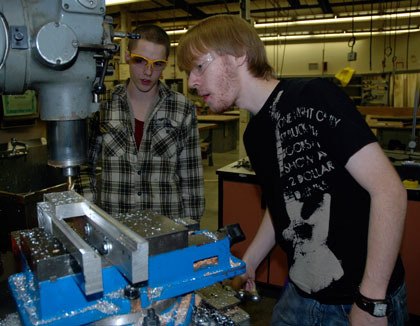TULALIP — The year has barely begun and the students of the Marysville Arts and Technology High School Robotics Team are already well into their six-week “build season” for their regional competition this spring.
Arts and Technology Robotics teacher Katherine Jordan estimated that the group’s membership has nearly doubled each year, and cited a laundry list of grants that have made the team’s participation in the annual FIRST Robotics Competition at the Qwest Field Event Center possible.
“We started out with eight members, then went to 15, and then 30,” Jordan said Jan. 12. “Just today, this year’s team became 50 members, and we’re continuing to accept new members.”
The team has received a $6,000 grant from NASA, a $1,000 grant from the state Office of Superintendent of Public Instruction, $2,000 from the Arts and Technology ASB, $5,000 from B/E Aerospace and another $1,000 from JCPenney. These grants help cover the team’s registration fees and travel costs, which allows them to exercise a more liberal approach to their membership.
“We’re willing to accept anybody who will work hard,” Jordan said. “We’ll teach them how to build a robot, but we’ll also show them how the arts fit into a project like this. Some of the challenges of this competition involve computer animation and video editing.”
Each year’s task is different. This year, robotics teams must build not only large robots that can pick up logo shapes from the ground and place them in order on a series of pegs on a wall, but also climbing “mini-bots” that can race to the tops of towers. Each team has only six weeks to design and build these robots before they’re packed up and shipped off to Qwest Field for the March 17-19 regional competition.
“The first week is just about gaining an understanding of what the challenges are and what the robots need to be able to do,” Jordan said. “We analyze the game to see how we can score or lose points. From there, we choose a design. Our design plan is modular because it allows us to attach or remove arms to the larger robots so they can be converted to blocking other robots’ goals.”
The actual building phase of the process takes up the next four weeks, which should finish in time to allow the teams one last week to double-check their programming and test-drive their robots.
“By practicing at the controls we can find out who the strongest driver is,” Jordan said. “That’s how Hailey got on the team last year. She beat all the boys.”
Hailey Wang joined the Arts and Technology Robotics Team during that sixth week of driver trials last year. This year, she’s a senior and the project manager for the entire team.
“I knew a lot of people on the team and it really seemed like fun,” said Wang, whose newfound love of robotics has inspired her to expand her possible career options from biology to biological engineering, or possibly even mechanical engineering. “I love that it’s a challenge. I’ve always gotten bored easily at school, so I like engineering for the fact that I don’t get it immediately.”
Wang has also learned, from working as part of a team, the value of listening to everyone’s input. While her leadership role on the team has given her the challenge she craved and then some, she’s grateful even for the headaches.
“It’s both hellish and fantastic,” Wang laughed. “I’m always busy keeping people connected and keeping it all together. I really do enjoy every single person here and every second that I’m spending on this.”



